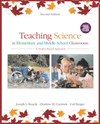| anxiety | Uneasiness and apprehension.
|
 |
 |
 |
| base groups | Groups of students who work together on a project.
|
 |
 |
 |
| cognitive load | Amount of work in acquiring or using knowledge.
|
 |
 |
 |
| cognitive roles | Roles that require a specific type of thinking or specialized knowledge.
|
 |
 |
 |
| collaboration | A joint intellectual effort of students, peers, teachers, and community members to investigate a question or problem.
|
 |
 |
 |
| division of labor | A process that occurs when students collaborate, negotiate, compromise, and interface with others to investigate a driving question.
|
 |
 |
 |
| duped | Trick or persuade someone to do something for you.
|
 |
 |
 |
| equality | The quantity or level of knowledge or ability that members bring to a group.
|
 |
 |
 |
| home groups | Groups that are used for critiquing work and supporting each other; may be used the entire school year.
|
 |
 |
 |
| interpersonal roles | Roles that help students work well among themselves.
|
 |
 |
 |
| learning contracts | Written agreements between the students and teacher which establish standards for completion of their work before it is begun by the student.
|
 |
 |
 |
| loafer effect | A phenomena that occurs when one or more group members allow others to do all the work.
|
 |
 |
 |
| managerial roles | Roles that help manage time and completion of a task.
|
 |
 |
 |
| meaning | A sense of purpose or significance.
|
 |
 |
 |
| mutuality | The common goals of the students.
|
 |
 |
 |
| pact | An agreement between two or more groups or individuals to complete a given amount of work with the least effort.
|
 |
 |
 |
| positive interdependence | The linking of all group members so that one cannot succeed unless the other group members succeed.
|
 |
 |
 |
| scaffolding | A process in which a more knowledgeable person uses various techniques, such as modeling or coaching, to direct those aspects of the intellectual task that are initially beyond the capacity of the learner.
|
 |
 |
 |
| sharing groups | Groups where students share information about their respective projects.
|
 |
 |
 |
| socially induced incompetence | A phenomena that occurs when members of a group ostracize or disparage a student to the point that he or she feels unable to contribute to the group's work.
|
 |
 |
 |
| status differential effect | A phenomena that occurs when a high-status member of a group takes control. Higher status can be caused by many things-cliques, socioeconomic status, race, older students working with younger ones, or academic achievement.
|
 |
 |
 |
| trust-building skills | Skills or processes that help make all students feel comfortable working in small groups.
|
 |
 |
 |
| zone of proximal development | The difference in performance between what a learner can accomplish unassisted and what he could accomplish with the assistance of a more knowledgeable or capable other.
|



 2003 McGraw-Hill Higher Education
2003 McGraw-Hill Higher Education